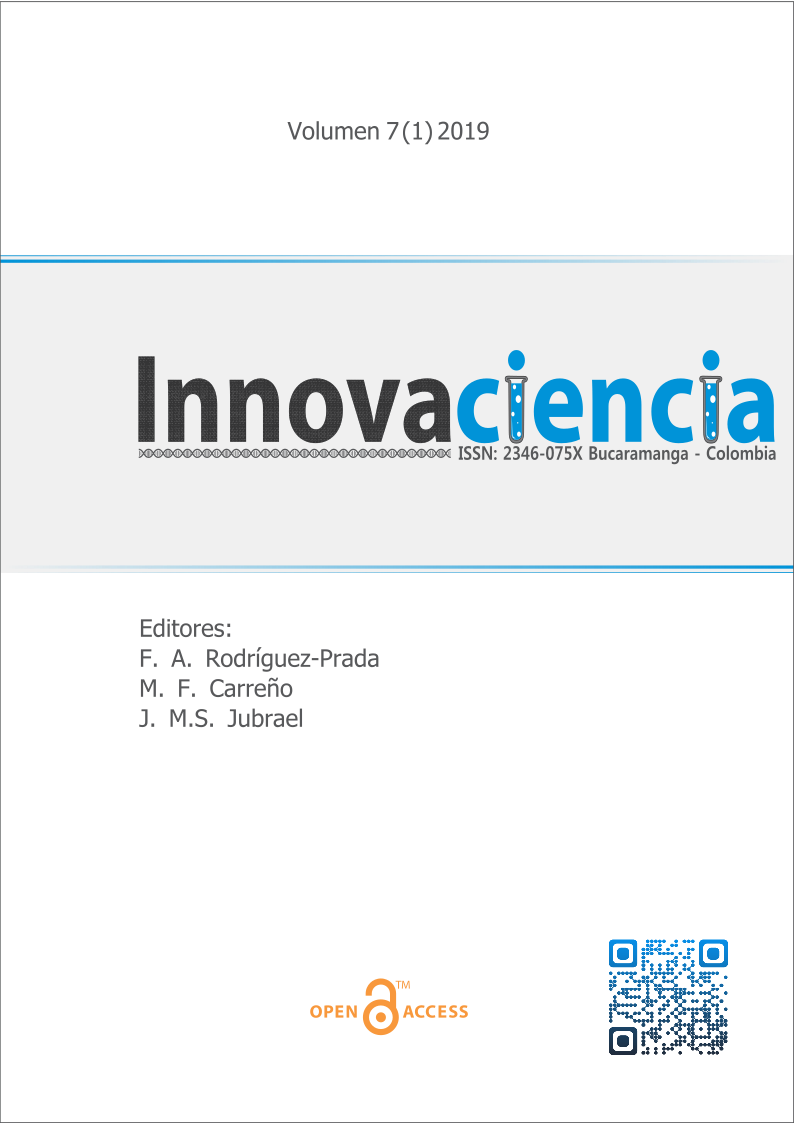Evaluación de un protector antipolvo electrostático de carga automática para aplicaciones de células solares en el clima exterior de Bagdad
DOI:
https://doi.org/10.15649/2346075X.788Palabras clave:
dust removing, electro-dynamic discharge, clearing factor, solar cellResumen
Introduction: It is well known that the biggest problem facing the utilizing of solar cell Panels in Baghdad is the unpredictable dusty weather through the days of year. This big problem is not easy to overcome due to the frequent dust accumulations and the high cost of cleaning and other maintenance problems. Dust problems are increasing due to global warming. In Baghdad city, where solar radiation is intense and available almost throughout the year, Deposition of dust on the panels could severely minimize solar-to power output efficiency. There are many methods for dust removing from surfaces like the natural dust removal of wind, mechanical dust removing, super-hydrophobic on solar panel surface, and the electrostatic method which is adopted in this work. The dust particles will be charged statistically by rolling on the surface of the solar panels they will have the same electric charge and the electrostatic forces between them are repulsion. Hence, the dust particles will float away from the solar panels. Materials and Methods: A self-charging transparent conductive glass is prepared by spraying a thin film (141 nm thickness) of a Tin dioxide (SnO2) solution on a glass substrate (12x12 cm2). The dust shield is connected to an electronic charging circuit. The shield is located on the top of a silicon solar cell. The novel idea is that the shield is electrically supplied by the solar cell itself whereas D.C. current from the solar cell itself is used to charge the conductive glass, which is located on the top surface of the cell. Results and Discussion: A test was done for dust removing from a Silicon solar cell by electrostatic repulsion method, considering matching the spectral response region of the Silicon
solar cells with the film transmittance spectral region (400 -700 nm). The transmittance value is between (92 – 95)% and results are compared with
an identical reference solar cell. Results show a good response as the calculated clearing factor value increases due to the cell efficiency increment.
Also, the clearing factor is discussed as a function of outdoor temperature to show a direct proportionality, while the environmental humidity showed an inverse proportionality. Conclusions: A self-cleaning method for a solar cell is successfully introduced via a conductive glass. tests were carried outdoor in Baghdad city. Results showed that there is a direct proportionality between both: the clearing factor and the efficiency gain with the ambient temperature. The ambient humidity showed indirect proportionality with system efficiency (clearing factor and efficiency gain show reduction as the humidity percentage increases).
Referencias
Abdullah M, et al. SnO2 Transparent Self- Cleaning Dust Shield for Solar Panels, International Journal of Application or Innovation in Engineering & Management (IJAIEM).2013; 2.
Holmes, Hannah. The Secret Life of Dust. Wiley. 2001.
Svarosky L. Powder Testing Guide: Methods of Measuring the Physical Properties of Bulk Powders (Elsevier Applied Science, Oxford 1987.
Mazumder M, et al. Electrostatic Removal of Particles and its Applications to Self-Cleaning Solar Panels and Solar Concentrators, Department of Electrical and Computer Engineering, Boston University, Boston. 2011. https://doi.org/10.1016/B978-1-4377-7885-4.10005-3
Masuda S and Aoyoma M. Characteristics of electric dust collector based on electric curtain, Proceedings of the General Conference of the Institute of Electronic Engineers, Japan, 1971, No. 821.
Krupp H. (1967), Adv. Colloid Interface Sci. 1 111. https://doi.org/10.1016/0001-8686(67)80004-6
Calle C, et al. Dust particle removal by electrostatic and dielectrophoretic forces with applications to NASA exploration missions. Proc. ESA Annual Meeting on Electrostatics, 2008; 1.
Liu G, Marshall J. Particle transport by standing waves on an electric curtain, Journal of Electrostatics. 2010; 68: 289. https://doi.org/10.1016/j.elstat.2010.02.004
PV measurements, inc, WA USA, pvmsales@pvmeasurements.com.
Abdullah M, e.al. Asian Academic Research Journal of Multidisciplinary. PLASMA ELECTRO-DYNAMIC DISCHARGE (PED) FOR SELF- CLEANING of DUST IN SOLAR PANELS, Reviewed International Journal of Asian 2016; 3 (6).
Rietema K. The Dynamics of Fine Powders Elsevier, UK. 1990. https://doi.org/10.1007/978-94-011-3672-3
Zhu J, et al. Nanodome solar cells with efficient light management and self-cleaning, Nano-Letter. 2010; 10: 1979– 1984. https://doi.org/10.1021/nl9034237

Descargas
Publicado
Cómo citar
Descargas
Número
Sección
Licencia
Todos los artículos publicados en esta revista científica están protegidos por los derechos de autor. Los autores retienen los derechos de autor y conceden a la revista el derecho de primera publicación con el trabajo simultáneamente licenciado bajo una Licencia Creative Commons Atribución-NoComercial 4.0 Internacional (CC BY-NC 4.0) que permite compartir el trabajo con reconocimiento de autoría y sin fines comerciales.
Los lectores pueden copiar y distribuir el material de este número de la revista para fines no comerciales en cualquier medio, siempre que se cite el trabajo original y se den crédito a los autores y a la revista.
Cualquier uso comercial del material de esta revista está estrictamente prohibido sin el permiso por escrito del titular de los derechos de autor.
Para obtener más información sobre los derechos de autor de la revista y las políticas de acceso abierto, por favor visite nuestro sitio web.















